Canale L.C.F., Mesquita R.A., Totten G.E. Failure Analysis of Heat Treated Steel Components
Подождите немного. Документ загружается.

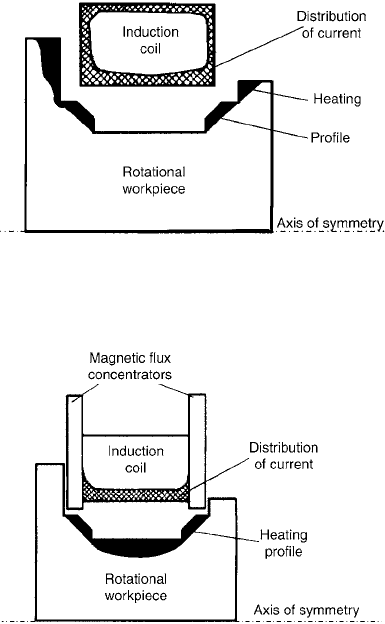
By placing the conductor into the magnetic
flux concentrator made of powder metals
based on iron, nickel, cobalt, and other
powder materials, it is possible to achieve a
higher density of the magnetic field
(Fig. 23c).
The concentrated magnetic field results in
localized heating on only those areas that are
meant to be hardened. The magnetic flux con-
centrator surrounds the conductor, so that the
current density on the conductor surface is
redistributed, as is the heating of the workpiece
material.
The effects of the magnetic flux concentrator
depend on:
Workpiece material and shape of the local
area to which heat is applied
Workpiece material and concentrator shape
The current density in this case is the highest
in point “A” of the conductor and is considerably
higher than in point “B”. This results in effective
local heating, where the length of the heated area
is only slightly greater than the width of the con-
ductor, but, due to the high density of the mag-
netic flux, a considerably greater depth of the
heated area is achieved.
As for concentrator material, different appli-
cations require the use of different materials.
The material for the concentrator must be chosen
after considering several factors:
Relative magnetic permeability
Magnetic reluctance
Flux density in saturation
Losses under magnetization
Resistance to high temperatures
Cooling abilities
Resistance to cooling effects of fire extin-
guishers
Good machinability
Adjustment to different shapes and sizes of
coils
Ease of assembly and disassembly
Manufacturing costs, depending on the kind
of material, induction heating parameters,
and geometry features between the con-
centrator and the workpiece
Figure 24 shows a local surface area with a
complex shape that is induction heated with a
single coil. Current density is in the inductor,
which results from the position of the inductor
with respect to the workpiece. This results in
differences in the current density, which are
reflected in the different heating/workpiece
depth profiles created by the differences in the
power density distribution (Ref 19, 42).
Figure 25 shows the same area and shape, but
heating was performed with a magnetic flux
concentrator (Ref 19, 42). This is placed on the
left and right sides of the surrounding coil, which
contributes to higher concentration of the mag-
netic flux to prevent heating of the sides of the
workpiece at this place. A redistribution of
power density took place, and a desirable local
heating profile of the workpiece was achieved.
Advantages offered by the magnetic flux
concentrator are:
Smaller consumption of power
Improved efficiency of heating
Better exploitation of equipment due to
shorter heating times
More selective heating of the workpiece
areas
Fig. 24
Heating profile on rotational workpiece with
induction coil. Source: Ref 42
Fig. 25
Heating profile on rotational workpiece with flux
concentrator. Source: Ref 42
438 / Failure Analysis of Heat Treated Steel Components
Name ///sr-nova/Dclabs_wip/Failure_Analysis/5113_417-501.pdf/Chap_13/ 18/8/2008 4:00PM Plate # 0 pg 438
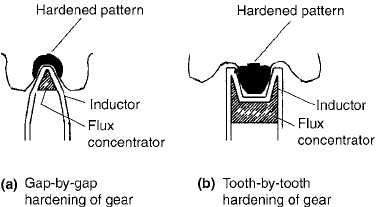
Achievement of desirable heating profiles of
hardened layer profiles
High repeatability of the procedure in terms
of hardened profile size and hardened layer
microstructure
Efficient protection from unwanted heating
of adjacent areas and successful prevention
of reheating and softening the already hard-
ened layers
Elimination of detrimental effects on the
operator’s health due to exposure to the
magnetic field
Improved operation lifetime of the heating
equipment and higher productivity
Less workpiece distortion and lower costs in
straightening and/or final grinding sub-
sequent to hardening
Reduction of the quantity of rejected parts in
terms of required size and shape of the hard-
ened layer and workpiece distortion and
cracking
Figure 26 shows two hardening procedures
for tooth profiles of gear wheels using appro-
priate induction coils with a ferritic core con-
centrating the magnetic field (Ref 19).
The first procedure is known as gap-by-gap
hardening (Fig. 26a), because the induction coil
with the ferritic core is moved in the tooth space
so that a suitable gap between a tooth profile and
the inductor is provided. The advantage of using
magnetic flux concentrators rather than the
conventional coil is that, with the same energy
input, heating time is shortened. Unfortunately,
the use of concentrators also shows some defi-
ciencies, since the transition zone between the
hardened and nonhardened microstructures,
which is very important for hardening, is lost due
to rapid heating. This results in less favorable
residual-stress and microhardness profiles of the
hardened layer. Thus, a greater risk of failure
is incurred at the point where teeth or other
machine parts are most strongly loaded, which is
at the transition from the hardened subsurface to
the nonhardened core, where an increased stress
concentration will occur. Such heating circum-
stances may be avoided by choosing lower-
energy inputs or power densities. In this case,
however, the case depth is more difficult to con-
trol. If a hardened-and-tempered microstructure
is to be provided at the tooth inside as well,
heating with two frequencies is applied. The
hardened-and-tempered microstructure may be
accomplished with only one frequency in heat
treatment of smaller gear wheels when the induc-
tion coil encompasses the entire gear wheel.
The second procedure is tooth-by-tooth
heating (Fig. 26b). In this case, the induction coil
is moved against a tooth so that an appropriate
gap is provided between the concentrator and the
surface of both flank profiles of the same tooth.
The difference between the two techniques is
that in gap-by-gap heating, two adjacent tooth
profiles and the root section of a gear wheel are
heated, whereas in tooth-by-tooth heating the
entire gear tooth is heated. Thus, in the first
example, only hardened gear wheel tooth pro-
files are obtained, whereas in the second ex-
ample, hardened tooth profiles of the gear wheel
and quenched and tempered tooth inside are
obtained.
Figures 27(a to d) show various automobile
parts that were induction surface hardened using
the single-shot or scan-hardening technique (Ref
19). They were prepared for macroscopic and
microscopic examinations of the hardened layer.
The segments of the individual specimens of
various characteristic and exacting automobile
parts after grinding, polishing, and macroetch-
ing permit identification of the profile of the
hardened pattern, for example, in the cross-
sectional and longitudinal direction of the part,
respectively, as well as an analysis of the micro-
structure and microhardness. Each figure also
indicates which technique of heating, that is,
single-shot hardening or scan hardening, and
which heating conditions (P, f ), using single-
turn or multiple-turn induction coils, were
employed.
The quality of the surface-hardening process
can often be efficiently assessed by measuring
the hardened-layer depth at different locations
on the individual parts. If the achieved depth is
very uniform, regardless of the location of mea-
surement, then the part was not subjected to
distortion. A sufficiently high initial hardening
Fig. 26
Gap-by-gap and tooth-by-tooth induction hardening
of gear wheels. Source: Ref 19
Induction Hardening / 439
Name ///sr-nova/Dclabs_wip/Failure_Analysis/5113_417-501.pdf/Chap_13/ 18/8/2008 4:00PM Plate # 0 pg 439
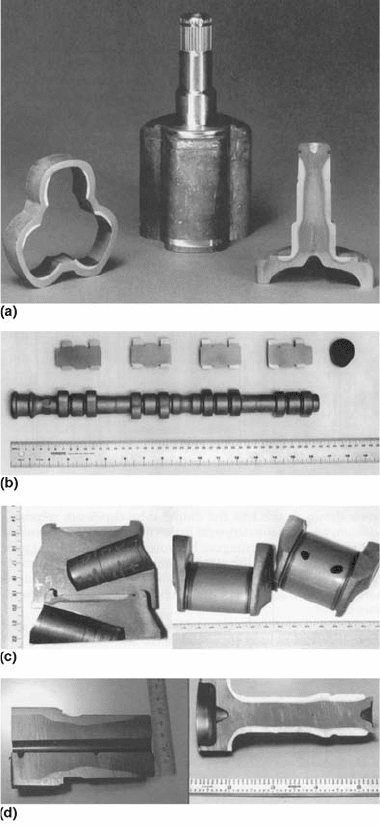
temperature provides an adequate through-depth
microhardness of the hardened profile. The
analysis is considered a destructive method,
because the part must be cut in the longitudinal
and transverse directions respectively, so that
the information required on the hardened pattern
may be obtained. Such methods are appropriate
only for periodical control, particularly statis-
tical control with periodical sampling. Based on
the results obtained for the characteristics of the
selected hardened pattern, the quality of an
article is confirmed or accepted and uninterrup-
ted production provided. These types of non-
destructive testing are long-standing; therefore,
nondestructive methods of testing the material
condition after induction hardening are grad-
ually being introduced. Of all the methods, mag-
netic and magnetic-induction methods have
established themselves because they are very
fast, reliable, and provide reproducible results.
The nondestructive methods of testing these
parts allow on-line supervision of part quality,
since, due to the speed of testing, all parts may be
tested, which is a general tendency in mass
production today.
Conditions in Induction Heating and
Quenching of Machine Parts
Heating of workpieces is done so that a
magnetic field is created in the inductor, which is
connected to a high-frequency generator. When
a ferromagnetic material or workpiece is intro-
duced into a magnetic field, eddy currents are
induced. The distribution of eddy currents in the
workpiece is specific, their density being highest
on the surface and decreasing toward the inside.
This phenomenon is known as the surface effect
or skin effect. Due to resistance offered by the
workpiece material, heating takes place mainly
in the thin surface layer, whereas the inner
core remains cold or is only slightly heated
(low-mass workpieces).
The depth of current penetration depends on
workpiece permeability, resistivity, and the
alternating-current frequency. Because the first
two factors vary comparatively little, the great-
est variable is frequency. Depth of current
penetration decreases as frequency increases.
High-frequency current generally is used when
shallow heating is desired; intermediate and low
frequencies are used in applications requiring
deeper heating.
Most induction surface-hardening applica-
tions require comparatively high power den-
sities and short heating cycles to restrict heating
Fig. 27
(a) Single-shot inductors used for both track (lobes)
and shaft of this automotive component. The part is
sectioned and acid etched to show the hardness pattern. All tracks
are hardened at the same time using 250 kW/30 kHz; the stem is
hardened using 135 kW/10 kHz. (b) Automotive right and left
cam shafts that have been selectively induction surface hardened.
The cam shaft was forged, heat treated, then final ground. No
premachining was necessary. The equipment used a dual-spindle
transfer mechanism; the coil was a four-turn coil that heated four
lobes per spindle at a time. Power was applied for each set of four
lobes: 150 kW, 10 kHz. The result is a 4.2 mm deep case depth
in the base circle of the cam. (c) Hardness patterns on carbon steel
crankshaft journals resulting from the stationary induction-
hardening process. (d) (Left) An unacceptable nonuniform hard-
ness pattern due to the nonuniformity of the workpiece, scanned
with a single-turn inductor. (Right) An acceptable hardness
profile achieved with a single-shot inductor. Source: Ref 19.
Courtesy of Inductoheat, Inc.
440 / Failure Analysis of Heat Treated Steel Components
Name ///sr-nova/Dclabs_wip/Failure_Analysis/5113_417-501.pdf/Chap_13/ 18/8/2008 4:00PM Plate # 0 pg 440

to the surface area. The principal metallurgical
advantages that may be obtained by surface
hardening with induction are the same as for
flame hardening. The drop in magnetic perme-
ability of steels depends on the temperature line,
T
A
2
, where steel transforms from magnetic into
nonmagnetic ferrite. The larger the effect of the
magnetic permeability change on the tempera-
ture line, T
A
2
, the smaller the carbon content in
the steel (the larger the proportion of ferrite in
the steel) and vice versa. Due to rapid heating,
phase transformation moves upward toward
higher temperatures. The temperature-time
curves of heating along the depth of a cylindrical
component depend on the kinetics of the mag-
netic transformation, T
A
2
, and the effects of other
phase transformations during induction heating.
A thickness of 1.0 to 1.5 mm is reached with a
medium-frequency current. The temperature-
time variation over the cross section of the steel
workpiece is a function of the following factors:
Penetration depth of eddy currents
Heat conduction of the material
Heating rate of the surface
Initial temperature of the surface
Size and shape of the workpiece
The depth of penetration of the heat is gov-
erned mainly by the power and frequency em-
ployed. The normal power density is 0.1 to 2 kW/
cm
2
of the heated surface. The relationship
between depth of penetration and frequency can
be calculated approximately by using simplified
expressions, which are valid for the temperature
rise in steel up to the hardening temperature
(Ref 16):
d
CS
=
20
ffiffiffi
f
p
cold state (20
C)
d
HS
=
500
ffiffiffi
f
p
hot state (800
C)
where d
CS
is the depth of penetration in the cold
state, measured in millimeters; d
HS
is the depth
of penetration in the hot state, measured in
millimeters; and f is the frequency, measured in
hertz.
Due to heat conduction in the material during
heating, the overall depth of penetration is larger.
It is possible to calculate the additional penetra-
tion due to heat conduction from the expression:
d
HC
=0:2
ffiffi
t
p
where t is time, measured in seconds; and d
HC
is
the depth of penetration for heat conduction,
measured in millimeters.
The total depth of penetration is obviously
d
T
= d
CS
+d
HC
. It should be stressed that these
expressions give only a rough estimate of the
depth of penetration, and they have been inclu-
ded here only to show the fundamental effects of
frequency and time.
In flame heating, the temperature achieved on
the surface at equal energy input is considerably
higher than in induction heating, the overheating
and the hardened layer thickness being depen-
dent on the heat conduction of the workpiece
material. Figure 28(a) shows the temperature-
time variation over the cross section of the
workpiece in flame heating (Ref 15). Charac-
teristic of this variation is that the temperature
rapidly changes with time, and therefore, the
conditions for the formation of a homogeneous
austenitic microstructure are not fulfilled.
Figure 28(b) shows the temperature–time
variation over the cross section of the workpiece
in induction heating. The temperature variation
is very similar to that in flame heating up to
magnetic transformation, that is, to line A
2
.At
temperatures higher than line A
2
, eddy currents
grow characteristically, and the rate of heating
decreases sharply. This slows down the heating
above temperature line A
2
. A reduced rate of
heating on the surface provides the conditions
for faster heating into the depth of the work-
piece. This figure shows that a relatively thin
layer is heated up, but the layer has a rather
homogeneous austenitic microstructure. The
temperature-time variation on the workpiece
cross section, or the temperature field, depends
on the workpiece size and shape. Thus, in heavy-
mass workpieces, faster heat abduction into the
remaining cold part of the workpiece is achieved,
and that is why the actual variation of tempera-
ture over the cross section is steeper. This means
that in heavy-mass workpieces, a higher surface
temperature than in low-mass workpieces must
be ensured to grant the same penetration depth.
The microstructural changes in induction
hardening depend to a large extent on the rate of
heating and subsequent cooling. The rates of
heating range from one to a few seconds, which
means that the diffusion processes may become
jeopardized. In steel, transformation of pearlite
into austenite takes place in induction heating at
almost the same temperature as in conventional
heating. In subeutectic steels suitable for surface
hardening, it is important that the induction
Induction Hardening / 441
Name ///sr-nova/Dclabs_wip/Failure_Analysis/5113_417-501.pdf/Chap_13/ 18/8/2008 4:00PM Plate # 0 pg 441
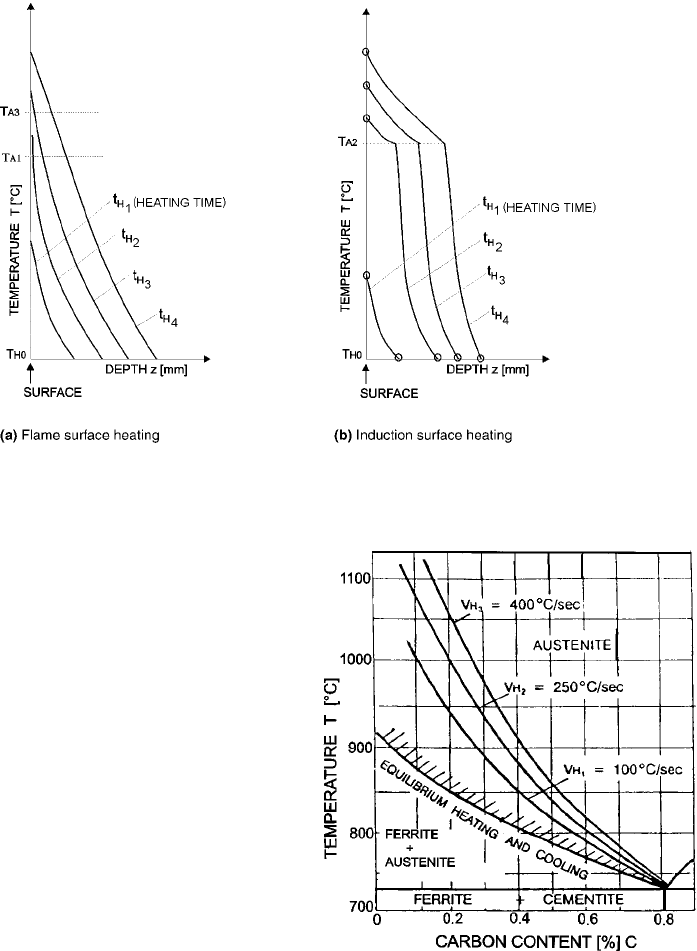
heating procedure ensures enough time for the
diffusion of carbon for transformation of ferrite
into homogeneous austenite (Ref 2, 16, 27, 29,
30).
Figure 29 shows the temperature line of
through hardening of subeutectic steels with
different carbon contents versus different heat-
ing rates (Ref 15, 27). The graph shows that
austenitization is clearly influenced by the
heating rate, especially when carbon con-
centrations are low to medium. Likewise, in the
case of rapid heating for through hardening, a
considerably higher temperature is needed than
for normal hardening. Thus, in surface hard-
ening carbon steels, it is difficult to ensure
enough homogeneous martensite, whereas in the
transition temperature range (T
A
1
to T
A
3
), a
higher homogenization of martensite is achieved
but with a presence of ferrite. The proportion of
ferrite in the transition temperature range is thus
higher with faster surface heating and smaller
carbon content in the steel.
In surface hardening alloyed steels, a better
homogenization of the austenite is achieved in
the heating phase, and when quenching is com-
pleted, a very homogeneous martensite with a
uniform microhardness along the depth of the
hardened layer is derived. Unfortunately, there
is a transition temperature range with a smaller
ferrite content, which causes a sharp drop in
hardness in the transition area with a hardened
and nonhardened microstructure.
A very important heating requirement in the
hardening procedure, besides the austenitization
temperature, is the time necessary for austeniti-
zation, since both of these heating parameters
Fig. 28
Temperature profile across the workpiece diameter in (a) flame surface heating and (b) induction surface heating. Source:
Ref 15
Fig. 29
Influence of induction surface heating rate on hard-
ening temperature for subeutectic steels. Source:
Ref 15, 27
442 / Failure Analysis of Heat Treated Steel Components
Name ///sr-nova/Dclabs_wip/Failure_Analysis/5113_417-501.pdf/Chap_13/ 18/8/2008 4:00PM Plate # 0 pg 442
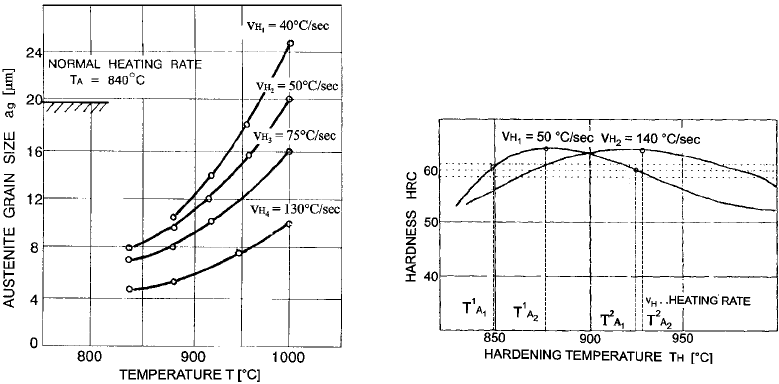
affect the size of austenitic grains. Austenitic
grain size is, on the other hand, dependent on the
martensite formed subsequent to quenching and
is reflected in the toughness of the surface layer.
That is why heat treatment conditions are sought
that would ensure the finest and most homo-
geneous austenitic microstructure in the heating
and overheating phases, leading to the formation
of very fine martensite with the highest possible
toughness of the hardened layer after quenching
(Ref 27, 29). This microstructural condition and
the achieved mechanical properties ensure good
wear resistance of machine components (gears)
and their good response under dynamic loads.
Figure 30 shows the growth of austenitic
grains for different rates of induction heating for
a steel with 0.4% C that can be used for induc-
tion hardening (Ref 15, 27). With increasing
rates of heating, the austenitic transformation
moves toward higher temperatures. A higher
heating temperature creates a higher formation
rate of austenitic crystal and therefore fine grains
of austenite. Subsequent to quenching, these fine
grains of austenite ensure a very fine martensitic
microstructure.
Figure 31 shows the relationship between
the hardened layer hardness and the heating
rate and temperature for a steel with 0.45% C
(Ref 15, 27).
For each steel, there exists a certain tem-
perature range after hardening that yields the
best microstructural condition and thus the best
properties. With higher rates of heating, this
range moves to higher temperatures. This means
that quenching from lower temperatures leads to
imperfect hardening, while higher temperatures
yield medium or rough needles of martensite.
The heating rate of 50
C/s is sufficient to reach
a hardening temperature range between 850 and
925
C. In the case of a higher-energy input that
heats up the thin surface layer with a rate higher
than 140
C/s, the required temperature range
becomes 870 to 970
C. In both cases, a surface
hardness of 60 HRC is reached subsequent to
quenching.
Figure 32(a–e) shows the entire process of
induction hardening a cylindrical component
with a small diameter or cross section, which,
subsequent to hardening, leads to self-tempering
(Ref 15, 27).
Figure 32(a and b) show induction heating of
a thin surface layer to the austenitic temperature
range, ensuring, a sufficient thickness of the
austenite layer d
2
subsequent to quenching. The
process of quenching or self-tempering is shown
in Fig. 32(c and d), where, due to heat conduc-
tion into the remaining cold part of the work-
piece, the temperature on the workpiece surface
layer increases, and thus, the thickness of the
austenite layer increased to d
3
or d
4
, respec-
tively.
Due to a small workpiece cross section or low
workpiece mass causing heat conduction, the
temperature in the middle of the workpiece rose
to a point corresponding to the tempering tem-
perature of the given material. Since the process
of tempering takes place in the workpiece with
the available heat needed for austenitization,
self-tempering of the workpiece is indicated
(Ref 27, 31, 32, 43).
Specific properties of the hardened layer can
be described by analyzing the microstructure
Fig. 30
Influence of surface heating rate on austenitic grain
size. Source: Ref 15, 27
Fig. 31
Hardness reached after induction surface hardening
at various heating rates in steel with 0.45% C.
Source: Ref 15, 27
Induction Hardening / 443
Name ///sr-nova/Dclabs_wip/Failure_Analysis/5113_417-501.pdf/Chap_13/ 18/8/2008 4:00PM Plate # 0 pg 443

with hardness measurements on the surface or
microhardness measurements in the cross sec-
tion of the hardened layer, and by measuring
residual stresses (Ref 27, 44, 45).
Figure 33 shows the hardness profile in the
hardened layer subsequent to induction surface
hardening (line 1) as a function of different
carbon content in the steel after conventional
hardening (line 2) (Ref 15, 27). Induction
surface-hardened layers normally have on the
average 3 HRC higher hardness on the surface
than that achieved in the same kind of steel after
conventional hardening. This is primarily due to
a finer martensite and compressive residual
stresses present in the induction surface-
hardened layer (Ref 2, 27, 46).
Time-Temperature Dependence in
Induction Heating
The time variation of temperature in induction
heating of a thin surface layer depends on the
type and shape of the induction coil used, the
alternating-current frequency, f (Hz), the and
power density Q (W/cm
2
). Power density is
defined by the selected power of the high-
frequency generator and the surface layer of
the workpiece. Surface heating depends on the
coupling between the induction coil and the
workpiece. Figure 34 shows the influence of
Fig. 32
Individual phases in induction heating and spray quenching in the workpiece surface layer and corresponding temperature-
diameter diagrams. Source: Ref 15, 27
Fig. 33
Influence of carbon content on steel hardness after
various heat treatments. Source: Ref 15, 27
444 / Failure Analysis of Heat Treated Steel Components
Name ///sr-nova/Dclabs_wip/Failure_Analysis/5113_417-501.pdf/Chap_13/ 18/8/2008 4:00PM Plate # 0 pg 444

the selected power density and frequency on the
reference depth of the skin effect in a ferro-
magnetic material (Ref 2, 20).
A higher power density results in a greater
reference depth of the skin effect and a greater
depth of the heated layer with the same maxi-
mum temperature obtained at the workpiece
surface. Figure 35 shows the interdependence
between the heating parameters, that is, power
density and generator frequency, as a function of
the specified depth of the hardened layer and the
heating time required for single-shot techniques
of surface induction hardening (Ref 2, 20).
The data supplied by the diagram can have a
character of information only, but they make the
selection of an optimal surface induction con-
dition easier. With the scanning technique of
surface induction hardening, however, the speed
of the workpiece movement, rather than time,
assures the depth of the required hardened layer
and should be defined. Generally, longer heating
times are required with smaller power densities
and vice versa. For the same depth of hardened
layer, longer heating times with lower current
frequencies are also required. With regard to the
depth of hardened layer selected between 0.5
and 10.0 mm, generator frequencies of 450, 10,
and 3 kHz can be selected in the single-shot
surface-hardening technique, in which case
appropriate power densities between 2 and
50 MW/m
2
are obtained. With lower high fre-
quencies, such as 10 kHz, the same depth of
surface-hardened layer, that is, 2.0 mm, can be
ensured only when the power density is changed
to 50 MW/m
2
. The lowest generator frequency,
3 MW/m
2
, shown in Fig. 35 cannot ensure the
depth of a hardened layer smaller than 2.5 mm.
Immediately after tempering, an intensive in-
verse heat flow is expected as well.
The power density and frequency used in
induction hardening are usually based on the
shape and size of the machine part to be surface
hardened; the case depth is specified also. In
addition to the depth of hardening, the case
pattern along the entire length of the machine
part is important.
Regardless of the complexity of a workpiece
shape, case depth and transition that are as uni-
form as possible as well as regular-shaped hard-
ened ends should be provided. Inadequate
pattern transitions may produce high stress
concentrations related to the given loads in its
vicinity, so the material cannot resist dynami-
cally loaded parts.
Fig. 34
Reference depth of skin effect as a function of power
density and selected generator frequency for ferro-
magnetic steel. Source: Ref 2, 20
Fig. 35
Influence of high-frequency generator on selection
of power density and heating time with given thick-
ness of surface induction-hardened layer. Source: Ref 2, 20
Induction Hardening / 445
Name ///sr-nova/Dclabs_wip/Failure_Analysis/5113_417-501.pdf/Chap_13/ 18/8/2008 4:01PM Plate # 0 pg 445

Various heating conditions that are defined by
the power density and frequency provide dif-
ferent pattern depths. The third influencing
parameter is heating time. Thus, different
hardness and residual-stress profiles may be
achieved. The steel grade to be hardened, the
loop shape, and the gap size between the
inductor and the workpiece should be con-
sidered. The data found in the diagram apply
only to stationary hardening; therefore, with
scanning surface hardening, these values
should be suitably corrected. For progressive
hardening, the hardening conditions should
be slightly corrected to allow for the loop
movement.
With the surface heat treatment processes,
studies are often conducted on the influence of
the selected heating and quenching conditions
on the depth of the hardened layer and the size of
the transition zone between the hardened and
nonhardened microstructures. One simple and
practical procedure to control surface heat
treatment is to measure the time variation of
temperature from the beginning to the end of the
heating process and also from the beginning to
the end of the quenching process. The heat
process may be changed by changing the power
density and the generator frequency, whereas the
quenching process may be changed by the
selection of different quenching agents and
quenching processes.
Figure 36 shows the measured and calculated
temperature cycles for the surface, the core, and
in a radius, r, of 7 mm in a depth of 1 mm in a
cylindrical specimen (Ref 47).
A comparison of the temperature cycles
shows that in surface induction hardening, a
thermal flow of 3 MW/mm
2
in heating and
5.8 MW/mm
2
in quenching was selected. Under
such heating conditions, a maximum tempera-
ture of nearly 1000
C was attained, while
heating above a temperature of 800
C was
somewhat slowed down. The data in the diagram
show that the time required for heating the speci-
men from the ambient temperature to 800
Cis
equal to the time required for heating from the
latter to the maximum temperature obtained at
the surface, that is, 1.6 s. A temperature cycle at
the surface takes 3.2 to 3.3 s. The temperature
differences between the surface and the core in a
given moment are the greatest during the heating
process, that is, DT
max
ffi600
C. During the
quenching process, however, they can reach up
to 360
C. Temperature gradient changes are
much stronger in heating than in quenching. In
material heating, there is also a great difference
in yield stress of the material, which can produce
plastic deformation. Another very important
finding (Ref 47) is that the theoretical model
is appropriate, since the results obtained
were confirmed by the standard experimental
methods such as temperature measurement with
thermocouples, diamond pyramid hardness test,
and measurement of residual stresses with x-ray
diffraction. The difference between the mea-
sured and the calculated temperature cycles is
very small. It occurs mainly in heating and
reaches up to 60
C at maximum, not taking into
account the losses due to eddy currents.
Figure 37 shows the variation of temperature
from the surface toward the core with various
volume power densities, Q, that is, 0.4 ·
10
9
, 1.2 · 10
9
, and 2.4 · 10
9
W/m
3
(Ref 48).
Fig. 36
Comparison of variations of calculated and mea-
sured temperature cycles for a cylindrical specimen
16 mm in diameter. Source: Ref 47
Fig. 37
Calculated variation of temperature through speci-
men cross section in induction heating up to
hardening temperature with different volume power densities.
Source: Ref 48
446 / Failure Analysis of Heat Treated Steel Components
Name ///sr-nova/Dclabs_wip/Failure_Analysis/5113_417-501.pdf/Chap_13/ 18/8/2008 4:01PM Plate # 0 pg 446

With smaller volume power densities, the maxi-
mum temperature differences between the sur-
face and the core also become smaller and the
austenitizing times longer. Because of higher
temperatures attained in the core, the inverse heat
flow may even be so high as to produce a change
in microstructure and, consequently, a reduction
of hardness in the surface layer.
The induction heating industry has standar-
dized power supply frequencies, and probably
99% of the power used will be at the frequencies
listed in Table 2. Also included in Table 2 is the
type of equipment used to a change 50 Hz (60 in
some countries) to a higher frequency and the
conversion efficiency (Ref 23).
Melander (Ref 49, 50) first treated single-shot
surface induction hardening of low-alloy steel
with 0.4% C, 0.7% Mn, and 1.1% Cr for tem-
pering and hardening as well as surface hard-
ening. For an analysis, a representative-sized
machine part that is most often used, that is,
a cylindrical specimen 40 mm in diameter,
was chosen. Induction-heating conditions were
selected so that the temperature of the diameter,
T
A
1
, was exceeded to a depth of 5.0 mm. This
means that a change of microstructure and hard-
ness was expected even to the depth of 5.0 mm,
where only partial austenitization was obtained.
Induction-heating conditions were chosen that
subjected the surface layer to heating for up to
35 s. Time variations of temperature at the sur-
face of the cylindrical specimen and in its sub-
surface at depths of 2.0, 4.0, and 10.0 mm are
shown in Fig. 38 (Ref 49, 50). Time-temperature
diagrams differ from the previous ones, since a
distinctive deviation occurs in heating the speci-
men material when the temperature of magnetic
domain, T
A
2
, is reached and exceeded.
The course of surface heating indicates that
the transformation temperature T
A
2
was ob-
tained in 10 s. In spite of the same power den-
sity, further heating of the surface up to a
temperature of 850
C was very slow due to the
nonmagnetic character of the steel surface layer;
it took another 28 s. It is difficult to assess which
models of induction heating are more suitable
than others. However, with the heating process
suggested, it is possible, after quenching, to
ensure a homogeneous, fine austenitic micro-
structure exhibiting the finest martensite with
the highest possible hardness of the given steel.
Due to the presence of alloying elements and
high cooling rates of the surface layer, in addi-
tion to fine martensite, up to 3% residual auste-
nite also appears. Based on the time-temperature
variation of heating, the depth of the hardened
layer ranges between 2.0 and 4.0 mm. From the
Table 2 Power sources, frequencies, efficiency,
and power for induction heating equipment
Type
Power (P),
kW
Efficiency (g),
%
Frequency
( f ), kHz
Vacuum tube
oscillators
5–600 50–60 200–450
Motor generators 7.5–500 75–80 1, 3, 10
Frequency multipliers 100–1000 90–95 180 and 540
Frequency inverters 50–1500 85–95 0.5, 1, 3, 10
Source: Ref 23
Fig. 38 Time-temperature cycle during single-shot surface induction heating and quenching. Source: Ref 49, 50
Induction Hardening / 447
Name ///sr-nova/Dclabs_wip/Failure_Analysis/5113_417-501.pdf/Chap_13/ 18/8/2008 4:01PM Plate # 0 pg 447
